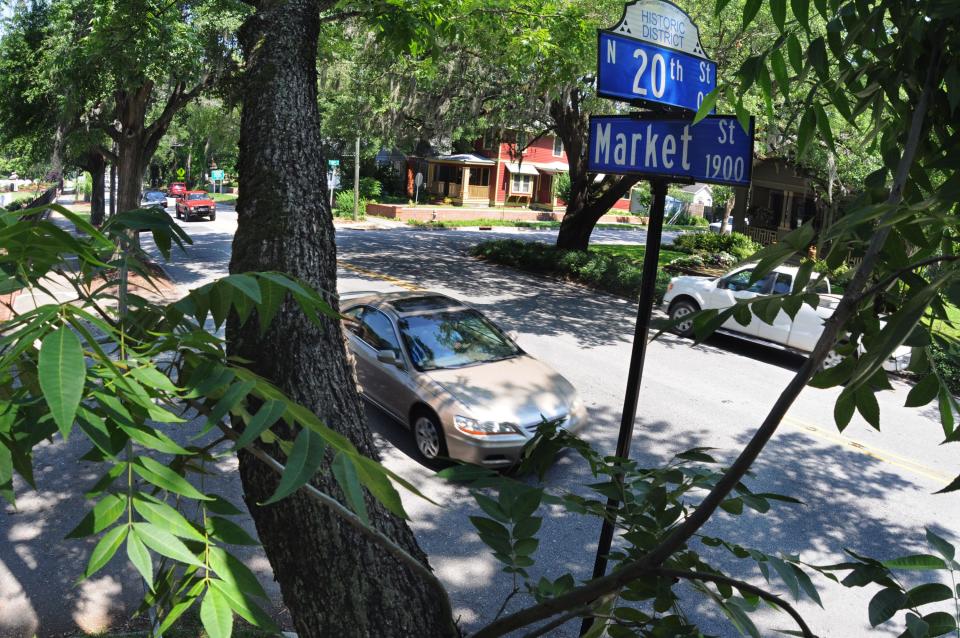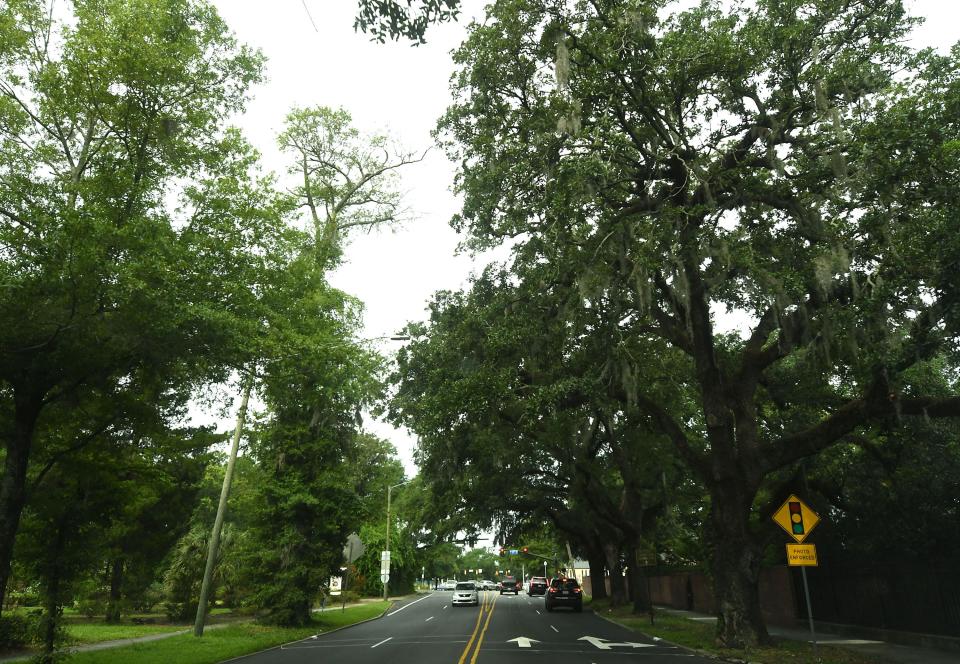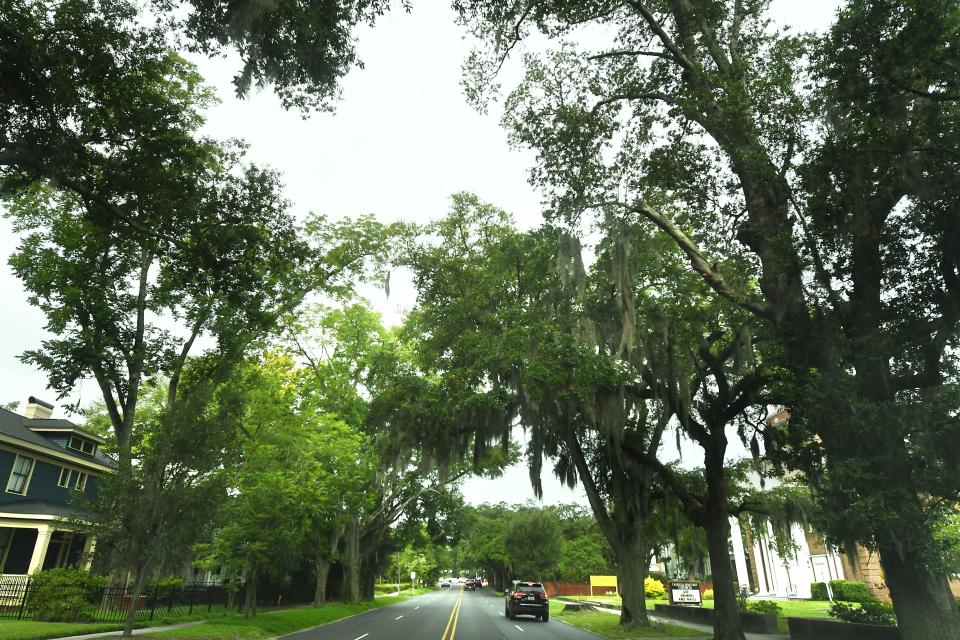Mature oaks have lined Wilmington's Market Street for decades. Now they face the ax.
An iconic "green" gateway into Wilmington is about to get a makeover, and no one is really happy about it.
But a combination of age, pollution and stress from more than 43,000 vehicles a day, disease and climate change means the massive tree removal project has to happen, city officials say.
“It’s a shame because it’s Market Street, such a prominent roadway and a place everyone is familiar with," said Connie Parker, president of the Alliance for Cape Fear Trees. "But sometimes trees do need to come down."
Before the end of the year, the city intends to remove up to 19 mature oak trees, some with trunks up to 55 inches in diameter, from a busy stretch of Market Street between 12th and 21st streets.
Amy Beatty, the city's community services director, told city council recently that the trees − all but one of which are laurel oaks − have become public safety hazards to passing motorists, pedestrians, bicyclists and the homes and businesses that line the historic Wilmington street.
Of the 19 trees, officials have determined 17 will have to be removed entirely and their stumps ground out. The remaining two will need further inspection to determine the best course of action.

GREEN THUMB Wilmington has lots of trees. Now it is developing a plan to better manage, care for them
While the occasional tree-vehicle collision along the narrow stretch of Market certainly hasn't helped, Beatty said the primary defect with the trees is heart rot, an untreatable fungal disease that causes thedecay of wood at the center of the trunk and branches. In many of the Market Street trees, the decay is in the trunk and crown areas. That can increase the chance of cracked trunks and falling limbs, especially during strong wind and rain events.
Last month, the city adopted its first urban forestry master plan that noted that a large majority of the trees in Wilmington's urban core are crepe myrtles and laurel oaks, trees that were selected decades ago in most cases because they were fast growing. Now that decision is coming back to haunt the city, and the new plan recommended that removing unhealthy trees will have long-term benefits for Wilmington's tree canopy.
But it's going to take a few decades to get back to what people are used to seeing now along places like Market Street.
Felling trees in the fall
Unlike long-lived, but slow growing live oaks often found along coastal parts of the Carolinas, laurel oaks have relatively short lifespans of 75-80 years. But with heart rot, that can be cut to as little as 50 years. The challenges of a clustered and tough environment like the Market Street corridor has placed additional stresses on the trees.
Seven of the trees slated for removal would be around the area of New Hanover High School. Another nine would be between 16th and 19th streets, with another two between 19th and 21st streets.
Beatty said the work will likely require partial to full closure of one to two blocks of Market Street at a time, with work taking place possibly both during the week and on weekends. The city will establish a timeline for the project with the N.C. Department of Transportation.

LIMITED OPTIONS Why Wilmington's neighborhoods aren't created equally when it comes to handling the heat
Work will likely take place in the fall, outside of the height of tourism season. New trees, likely with a diameter of at least 3 inches, will then be replanted in early to mid-spring 2024. It will be a tree-for-tree replacement, and the contract will include a watering requirement.
While the focus will be on planting new long-living and urban-tolerant trees, don't expect them all to be live oaks.
"Diversity in the urban forest can be really important for long term sustainability and survival," Sally Thigpen, the community services assistant director, told council. "We want to avoid having monoculture of trees that could be impacted by insects or disease as they mature in the landscape."
The city's urban forestry plan noted that Wilmington has an overabundance of crepe myrtles, at 28% of all street trees, and laurel oaks, at 14%.
Multiple benefits from trees
The loss of the prominent Market Street trees promises to shine additional sunlight onto the busy roadway. But the change won't have just a visual impact, negative to many.
As climate change warms the planet, researchers and health officials are increasingly singing the praises of urban trees − especially when it comes to helping dissipate the health impacts from urban "heat islands" caused by the rising temperatures. Urban heat islands are areas where unshaded roads and buildings gain heat during the day and radiate that heat into the surrounding air, leading to "hot spots" that can be several degrees warmer than surrounding areas cooled by trees. Among the biggest emerging problems worrying researchers is the lack of "cool-down" time for buildings and humans due to temperatures staying much warmer at night. Humid nights are dangerous because it makes the body work harder to stay cool, putting a strain on organs such as the heart.
SURVIVORS FACE NEW CHALLENGE Ancient NC trees have survived thousands of years. Will they weather climate change?
Trees also are fantastic carbon sinks, with a mature tree able to absorb nearly 48 pounds of carbon dioxide, the chief warming greenhouse gas in the atmosphere, and suck up vast amounts of stormwater runoff through their roots. Trees also are well-known tools to help people reduce stress, connect with nature, enhance property values, and beautify their homes and neighborhoods.
But climate change also has taken its toll on Wilmington's treescape, with hurricanes and other storm events battering the city's urban canopy in recent years. Scientists say the warming temperatures are making weather events more unpredictable and dangerous. Five years ago Hurricane Florence, for example, drenched Southeastern North Carolina with up to 3 feet of rain in places and sustained winds of 90 mph that pummeled the region for days.
Parker, the presidents of the local tree alliance, said getting healthier trees in the ground along Market that will grow to be beautiful, stable and long-lived shade trees is a step in the right direction.

But getting the corridor's tree canopy back isn't going to happen overnight.
“It doesn’t take 50 to 100 years for a tree to develop a big canopy," Parker said. "But it’s not going to happen next year, and it’s not going to look good next year. That’s just the way it’s going to be.
"I'm the first to say I'm going to hate seeing those trees come down. But I do understand the need for it."
Reporter Gareth McGrath can be reached at GMcGrath@Gannett.com or @GarethMcGrathSN on Twitter. This story was produced with financial support from 1Earth Fund and the Prentice Foundation. The USA TODAY Network maintains full editorial control of the work.
This article originally appeared on Wilmington StarNews: Wilmington to chop down mature unhealthy oak trees along Market Street

